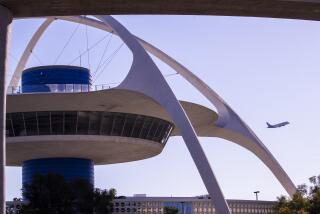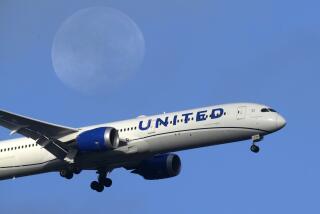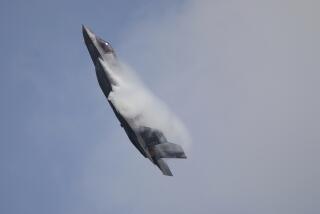Clinton Wasn’t Endangered by Jet Incident, Officials Say
- Share via
WASHINGTON — Air Force officials were at a loss Wednesday to explain how President Clinton’s aircraft had come within three miles of a United Parcel Service cargo plane off the coast of Ireland--and had to alter its course--last month as Clinton headed for Europe.
But along with federal air safety officials, they discounted the seriousness of the incident.
“The president was never really in danger,” said Capt. Keri Humphrey, a spokeswoman for the Air Force, which operates Air Force One, the president’s plane.
Humphrey said Clinton’s plane received “a low-level warning” of danger that led the pilot suddenly to climb 20 degrees and make a left turn.
She said that the warning was sounded by Air Force One’s on-board collision avoidance system. Traffic controllers at Shannon Airport also advised the maneuver.
The pilot of the cargo plane, flying in an opposite direction, said the planes passed close enough for him to file a report with federal authorities. He said the incident shows that cargo aircraft such as the one he was flying should be equipped with warning devices similar to passenger planes.
Officials at the Federal Aviation Administration and the National Transportation Safety Board said that the incident was not serious enough to cause them concern.
*
Aircraft generally are expected to stay apart by one or two miles horizontally and 1,000 feet vertically.
The incident occurred in the early morning darkness of May 27, and Clinton was not aware of any problem, officials said.
Humphrey said Air Force One was “on course” to Paris from Andrews Air Force Base near Washington with Clinton and his entourage, including First Lady Hillary Rodham Clinton, for the start of his recent European tour. She said the UPS aircraft also was “outside the minimum distance required by the FAA for transatlantic airspace.”
The electronic collision-avoidance device “provides an extra margin of safety” by alerting the pilot to other traffic five miles away, Humphrey said.
Maj. Jim Stratford of Andrews Air Force Base said he was also unable to explain why the planes had come close enough to cause Air Force One to adjust its course, but added that “there are midflight corrections in any flight plan.” He said Shannon Airport controllers “may have seen the planes were going to pass but felt it was too close.”
Dom DeVito, the UPS pilot, said he did not realize another plane was in the vicinity until an air traffic controller told him to take evasive action. “I’d like to meet the president, but I didn’t want to run into him this way,” DeVito told reporters.
*
DeVito and officials with the Independent Pilots Assn., which represents UPS pilots, said the incident demonstrated why cargo planes should be required to have anti-collision systems.
“Perhaps if we did, it would have avoided a close incident and we would not have to depend on Shannon control for our evasive maneuvers,” he said.
Fleet Smith, a pilot who investigated the incident for the association, said: “This is just an example of what can happen. Aircraft can get too close. Mistakes are made.”
More to Read
Sign up for Essential California
The most important California stories and recommendations in your inbox every morning.
You may occasionally receive promotional content from the Los Angeles Times.










